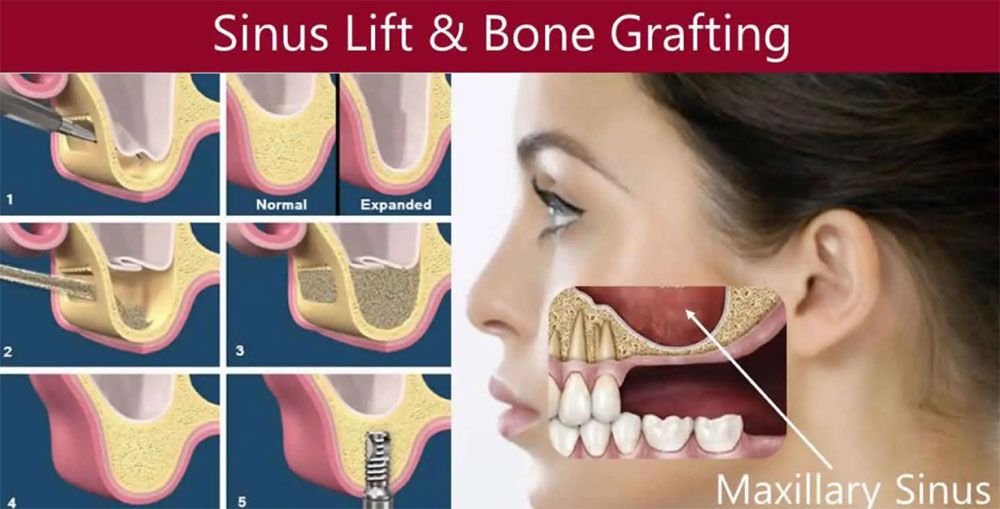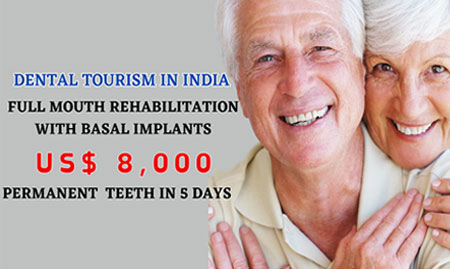
Dr. K Sharada Reddy, Author
Senior Dentist & Full Mouth Rehabilitation Expert
Patients with severe upper jaw bone loss (atrophic maxilla) are often told they need sinus lift surgery and bone grafts before they can receive full mouth dental implants. However, modern Implantology now offers graftless dental implants solutions that avoid these invasive, time consuming procedures and provide immediate loading dental implants.
Among these options, basal implants were once the only option as Sinus lift alternative dental Implants, to place implants in compromised jaws without sinus lifts or bone grafts. But today, basal implants are no longer the preferred option as they come with many set of drawbacks, and especially when universally accepted conventional implants can now be placed graft-free using the revolutionary CPBCCI Protocol™.
Let’s break down the comparisons and help you understand why international patients should make informed decisions, particularly when traveling abroad for full mouth rehabilitation. Advanced dental implant procedures is a life-changing solution for patients who have lost all or most of their teeth. However, not all patients are candidates for immediate loading dental implants especially those with severe bone loss in the upper jaw. In such cases, procedures like sinus lifts and bone grafts are traditionally recommended to create a foundation strong enough to support dental implants,
In this blog, we’ll explore:
- What sinus lifts and bone grafts are
- Their advantages and drawbacks
- Sinus lift alternative dental implants
- Sinus lift vs Graftless implants
- Why basal implants, once the only graft less option, are now giving way to universally accepted conventional implants
- And how the CPBCCI Protocol™ at LBR Dental & Implant Center, considered as the Best dental implant clinic in India, combines the best of both worlds for dental implants without sinus lifts and bone grafts, or compromise.
What Is a Sinus Lift?
A sinus lift (also called sinus augmentation) is a surgical procedure procedure that lifts the sinus membrane to insert bone graft material, making room for implants. This procedure is designed to increase the height of bone in the upper jaw, particularly in the posterior maxilla (back teeth region) where the sinus cavity often encroaches due to bone loss after tooth extraction.

Why is it Needed:
The posterior segment of the upper jaw often has less bone density than other areas, added to this the sinus cavity expands downwards (pneumatization) when teeth in this region are not replaced immediately after extraction, reducing available bone height.
A sinus lift procedure is advocated to raise the sinus membrane that has come down due to long standing absence of teeth and placement of bone graft material beneath it to create a stable base for implants.
What Is Bone Grafting?
Bone grafting is the process of adding or rebuilding bone in areas where there is insufficient natural bone to support dental implants. Bone (from your body or a donor) is added to regenerate lost jawbone, which takes 6–9 months to integrate before implants can be placed. It may be done using
Autografts (from the patient’s own body)
Allografts (from a human donor)
Xenografts (from animal sources)
Alloplasts (synthetic materials)
When Are Sinus Lifts and Bone Grafts Required in Full Mouth Reconstruction?
These procedures are usually considered when:
- There is significant vertical bone loss in the upper jaw.
- The sinus has dropped too low, leaving less than 5–6 mm of bone height.
- The patient is being treated with traditional implant protocols, where at least 10 mm of bone height is preferred for implant stability.
- The patient has severe ridge atrophy in the maxilla or mandible.
- There is no sufficient bone to accommodate and stabilize implants in the available bone.
Benefits:
- Rebuilds lost bone
- Allows standard implant placement
- Restores jaw structure
Drawbacks:
- Invasive and uncomfortable
- Long healing period (6–12 months)
- Risk of infection, graft failure, or sinus complications
- Increases treatment cost and time
- Delays placement of fixed teeth
Drawbacks of Sinus Lifts and Bone Grafts;Can I avoid Sinus lifts for Implants
| Drawback | Description |
|---|---|
| Extended Treatment Time | Healing time after bone grafting or sinus lift can be 6–9 months before implants are placed. |
| Invasive Surgical Procedure | These procedures involve additional surgery, increasing discomfort, swelling, and healing time. |
| Increased Cost | Adds to the overall cost of full mouth rehabilitation due to materials and extra surgical time. |
| Risk of Complications | Possibility of sinus membrane perforation, infection, graft failure, or chronic sinusitis. |
| No Guarantee of Success | Grafted bone may resorb or fail to integrate, leading to repeat procedures or altered plans. |
| Delays Immediate Loading | Immediate fixed teeth will not be possible with sinus lift and grafting protocols. |
The Evolution of Full Mouth dental implants India: Sinus lift alternative dental implants
Thanks to innovations like Pterygoid implants, Zygomatic implants in India, and the CPBCCI Protocol™ using conventional implants, sinus lifts and bone grafts are no longer required in full mouth dental implants India.
Why Graftless dental implants India Are Preferred Today:
- Avoid multiple surgeries
- Faster turnaround (fixed teeth in 7 days India)
- Less discomfort and downtime
- No sinus or graft-related complications
- Cost-effective and predictable outcomes
- Use native bone (pterygoid, nasal floor, cortical bone) for immediate stability
Summary Table: Sinus Lift vs. Graftless Implants, Full Mouth Reconstruction without sinus surgery
| Criteria | Sinus Lift + Bone Grafting | Graftless Protocol (e.g., CPBCCI) |
|---|---|---|
| Surgery | Invasive | Minimally invasive |
| Healing Time | 6–9 months | 5 to 7 days |
| Immediate Loading | Not possible | Immediate loading of permanent teeth in less than a week |
| Risk | Higher (sinus membrane tear, graft failure) | Lower |
| Cost | Higher | Costs lesser when compared to grafting procedures |
| Comfort | Moderate to low | High |
| Bone Source | Grafted | Native bone |
| Prosthetic Options | Hybrid | Zirconia on titanium framework, ceramic, DMLS |
| Global Acceptance | Yes | Yes (if using conventional implants) |
While sinus lifts and bone grafts were once considered essential for full mouth rehabilitation, modern implantology offers smarter, faster, and after graft less alternatives like Pterygoid implants in India and Zygomatic implants India
If you have been told you’re not eligible for implants without bone grafts, or that sinus surgery is your only option get a second opinion from Best dental Implant clinic in India that uses advanced protocols like CPBCCI™ with Conventional implants.
These approaches:
- Preserve bone
- Avoid invasive procedures
- Immediate loading dental implants
- Deliver fixed teeth in 7 days
- And most importantly, use Safe dental implants abroad with FDA approved systems, unlike basal implants.
Drawbacks of Basal Implants : What Patients Must Know
Basal implants emerged as a graft less solution for atrophic maxilla by anchoring into the basal (cortical) bone. While they propose immediate loading dental Implants, they come with significant drawbacks, especially for international patients.
1. Lack of Osseo integration
Basal implants promise Full mouth reconstruction without sinus surgery but they do not biologically fuse with the bone. They rely on mechanical fixation (osseofixation) rather than Osseo Integration. This mechanical anchorage may not offer the long-term bone implant stability that is characteristic of conventional implants.
2. Cement Retained, Non Retreivable Prosthèses
Basal implants are typically single piece systems and require cement retained prostheses. This means:
They cannot be removed if repairs or adjustments are needed.
If a tooth chips or breaks, the entire metal framework and prosthesis must be cut into pieces and replaced, which is traumatic and expensive.
In contrast, conventional two-piece implants allow screw-retained prostheses that are easily removed for repair and the same bridge refixed, and is also easy for cleaning, or upgrades.
3. No Abutment, No Angulation Control
Basal implants are monoblock which is a single-piece system. Their angle cannot be adjusted at the gum level like two-piece Conventional implants.
To correct angulation:
- The implant shaft is physically bent, which can:
- Fracture the implant
- Damage the jawbone
- Compromise long-term stability
Conventional implants also called as the Two piece Implant system, come with multi-unit abutments that safely correct angulation without stressing the implant or bone and are therefore considered as the best dental implants without bone grafts or sinus lifts
4. Not FDA Approved or Globally Accepted
Basal implants:
- Are not FDA approved
- Are not practiced or recommended in developed nations such as the USA, UK, Australia, or Canada
- Have limited long-term scientific backing or academic curriculum in reputed dental institutions
This puts international patients at risk of:
- Compromised post-treatment care back home
- Lack of follow-up options
- Lower confidence from local dentists unfamiliar with the system

Conventional implants with CPBCCI Protocol™ : The Best of Both Worlds
At LBR Dental & Implant Center, Best dental clinic for full mouth implants in Hyderabad, India, Dr. K A Reddy has developed the CPBCCI Protocol™ (Crestal Polished Bi-Cortical Conventional Implant) that eliminates the need for bone grafts or sinus lifts, without resorting to basal implants.
Why CPBCCI Protocol™ is Superior:
| Feature | Implants with Sinus Lift + Graft | Basal Implants | CPBCCI Protocol™ |
|---|---|---|---|
| Grafting Required | Yes | No | No |
| Sinus Lift | Yes | No | No |
| Time for Fixed Teeth | 6–12 months | 5 to 7 days | 5 to 7 days |
| Osseointegration | Yes | No | Yes |
| Prosthesis Type | Cement/Screw | Cement | Screw-Retained |
| Adjustability | Yes | No | Yes with Multiunit abutments |
| Global Approval | Yes | No | Yes, FDA approved systems |
| Long-Term Maintenance | Moderate | Difficult | Easy |
| Aesthetic Options | Limited in the initial phase | Limited | Full range including Zirconia |
For International Patients: Choose Wisely
If you’re traveling abroad for dental implants in India, choosing the right implant system is critical.
Ask yourself:
- Can your implant be maintained or repaired back home?
- Is the implant system FDA-approved and globally practiced?
- Will your prosthesis be easily removable for hygiene and repair?
- Are you being offered permanent fixed teeth with proven technology or just a “quick fix”?
Warning: Many patients are lured by the low cost and “immediate loading dental implants” claims of basal implant clinics. But lack of global acceptance, mechanical-only anchorage, and non removable prostheses can lead to serious complications.
Why CPBCCI Protocol™ at LBR Dental Is the Safer, Smarter Choice for Dental tourism India:
- Graftless dental implants india
- Safe dental Implants abroad with FDA-approved systems
- Fixed teeth in 7 days India
- Multi-unit abutments allow perfect angulation
- Zirconia teeth on conventional implants India
- Easily maintainable, removable screw-retained prostheses
- Dental implants with no sinus complications
- Ideal for overseas patients from USA, UK, Australia, Canada, and beyond
Final Word
When conventional implants offer everything basal implants do and more without the risks, discomfort, or long-term maintenance issues, there’s no reason to settle for outdated systems.
The CPBCCI Protocol™ gives you the power to walk away from sinus lifts, avoid bone grafts, and still receive fixed, beautiful, and reliable teeth immediately all using globally accepted, biocompatible, and long-lasting implant systems.
Book Your Free virtual Consultation Today .
Considering full mouth dental implants India but concerned about bone loss, sinus lifts, or basal implant complications? Avoid unnecessary sinus lifts and bone grafts. Discover how we place conventional implants without waiting or grafting, even in severe bone loss cases.
LBR Dental & Implant Center, Hyderabad, India
www.lbrdentalimplants.com
[email protected]
Call/WhatsApp: +91-98490 08623
Frequently asked questions
Yes, you can. Thanks to advancements like the CPBCCI Protocol™ used at LBR Dental & Implant Center in India, patients with severe upper jaw bone loss can receive graftless dental implants without undergoing sinus lift surgery or bone grafting. This protocol uses FDA-approved conventional implants placed in native cortical bone such as the pterygoid and nasal floor regions, eliminating the need for invasive grafting procedures.
While basal implants were once considered a viable graft less alternative, they are now largely outdated and not globally accepted. These implants rely on mechanical fixation, not biological fusion (osseointegration), and support non-removable, cemented prostheses that are difficult to maintain. Additionally, basal implants are not FDA approved and lack support from academic dental institutions in countries like the USA, UK, or Australia. Patients are now encouraged to choose safer and more proven alternatives like the CPBCCI Protocol™ using conventional, two-piece implants.
With graftless protocols like CPBCCI™, permanent fixed teeth can be delivered within 5 to 7 days. This is in sharp contrast to traditional bone grafting and sinus lift methods that require a healing period of 6 to 12 months before final prosthesis placement. Immediate loading is possible because the implants are anchored securely in dense, native cortical bone.
Yes, sinus lift surgery is an invasive procedure that involves lifting the sinus membrane and placing graft material. It requires months of healing, can cause discomfort, and carries risks like infection or sinus complications. Most patients prefer to avoid it if possible, especially when modern graftless techniques can achieve the same or better results in less time and with fewer complications.
Some of the known risks include sinus membrane perforation, infection, graft failure, extended healing time, and an overall increase in treatment duration and cost. Moreover, even after months of healing, there’s no guarantee that the graft will integrate successfully, which may further delay or alter the implant plan.
Yes, especially when used with protocols like CPBCCI™. Conventional implants allow osseointegration, use screw-retained prostheses that are easier to repair or clean, and offer multi-unit abutments for angulation control. They are globally accepted, FDA-approved, and offer long-term stability, making them the preferred choice over basal implants.
Absolutely. If you've been told you’re not a candidate for implants due to severe bone loss or a dropped sinus, you should seek a second opinion from a clinic offering advanced graftless protocols like the CPBCCI™. These techniques engage native cortical bone, eliminating the need for bone grafts or sinus lifts while still delivering full mouth rehabilitation.
At LBR Dental & Implant Center, patients receive permanent teeth, not just temporaries in as little as 5 to 7 days. These are typically Zirconia or ceramic prostheses fixed on conventional implants placed using the CPBCCI Protocol™, ensuring long-term function and aesthetics.
Yes, the CPBCCI Protocol™ uses globally recognized, FDA-approved implant systems and follows international best practices in implantology. The prostheses are screw-retained, making them easy to maintain or repair back home. This makes it an ideal option for patients from the USA, UK, Australia, and other developed nations who seek quality care without the risks of lesser-known or unapproved systems like basal implants.
Most patients even those with severe bone loss in the upper jaw—are eligible for graftless solutions when assessed by experienced implantologists. A clinical evaluation with CBCT imaging can determine your candidacy. Clinics like LBR Dental specialize in treating complex cases using advanced techniques such as pterygoid and zygomatic implants or the CPBCCI Protocol™ with conventional implants.




